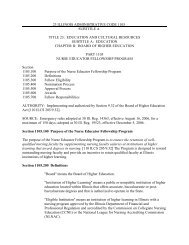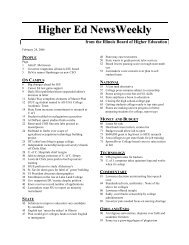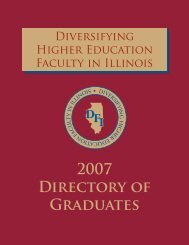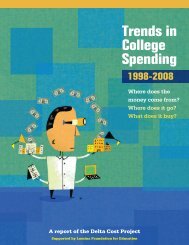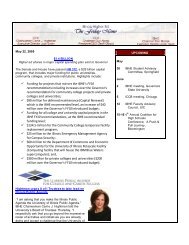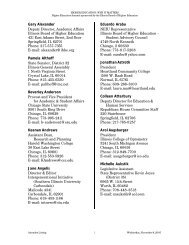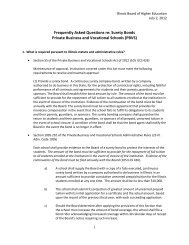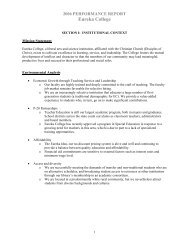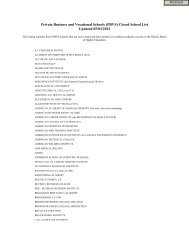A Report on the Feasibility of Textbook Rental - IBHE
A Report on the Feasibility of Textbook Rental - IBHE
A Report on the Feasibility of Textbook Rental - IBHE
You also want an ePaper? Increase the reach of your titles
YUMPU automatically turns print PDFs into web optimized ePapers that Google loves.
pricing model (see page 12).(www.immagic.com/eLibrary/ARCHIVES/GENERAL/IMM/I061215F.pdf)Pricing• For clarity, it is important to differentiate “new” vs. “used” textbook sales and pricing. Publishersand authors receive revenue <strong>on</strong>ly from <strong>the</strong> <strong>on</strong>e time sale <strong>of</strong> new textbooks and course materials.All m<strong>on</strong>ey from <strong>the</strong> subsequent sale <strong>of</strong> used textbooks goes to <strong>the</strong> book wholesalers, bookstoresand <strong>on</strong>line sellers. Publishers’ risks are much higher than resellers – publishing is a competitivemarket and <strong>the</strong>re is no guarantee that faculty will adopt <strong>the</strong> materials developed by a publisher –and publishers must recoup <strong>the</strong>ir entire investment in a single sale. Bookstores have a guaranteedmarket for <strong>the</strong> course materials <strong>the</strong>y order because <strong>the</strong>y order <strong>on</strong>ly those materials that havealready been adopted by faculty. And, if <strong>the</strong> bookstores order too many new course materials<strong>the</strong>n <strong>the</strong> bookstores can return <strong>the</strong>m to <strong>the</strong> publisher. These statements are not intended todiminish <strong>the</strong> c<strong>on</strong>tributi<strong>on</strong> <strong>of</strong> bookstores but to ensure understanding <strong>of</strong> <strong>the</strong> risk and return factorswithin <strong>the</strong> market.• Page 13, para. 1, line 1 – “…factors impact NEW textbook prices…”• Page 14, para. <strong>on</strong>e, line 6 “…75 cents <strong>of</strong> every NEW textbook dollar…”• The chart shown <strong>on</strong> page 14 should be labeled NEW textbook dollar distributi<strong>on</strong>. AAP alsosuggests that <strong>IBHE</strong> include <strong>the</strong> figure attached in Appendix B, which visually represents <strong>the</strong> salescycle for college textbooks.Bundling• Page 15, para. 1 – “…limits <strong>the</strong> ability to purchase used course materials and sell back all coursematerials in <strong>the</strong> bundled package.” – Some packaged items are designed for reuse, such as CDsthat accompany art texts and s<strong>of</strong>tware that is included with ec<strong>on</strong>omics texts. O<strong>the</strong>r materials,such as graded <strong>on</strong>line homework and <strong>on</strong>line tutoring, are purchased as c<strong>on</strong>sumable products foruse for a specific period <strong>of</strong> time, such as <strong>on</strong>e, two or three semesters. Publishers do sell productssuch as access codes and workbooks a la carte so that bookstores can sell <strong>the</strong>m with usedtextbooks.• Page 15, para. 2 – “CALPIRG…reports bundled textbooks and course materials account for half<strong>of</strong> all textbook sales.” – AAP sales data directly c<strong>on</strong>tradicts CalPIRG’s asserti<strong>on</strong> about bundledtextbooks. CalPIRG’s “study” was based <strong>on</strong> 50 textbooks – five each from 10 differentbookstores – out <strong>of</strong> <strong>the</strong> more than 262,000 titles currently <strong>on</strong> sale. According to AAP data, asreported by <strong>the</strong> six major textbook publishers for 2004-05, <strong>on</strong>ly 37% <strong>of</strong> all net print product salesare packaged products. See Appendix C.• Page 15, para. 3 – “CALPIRG reports that students did not have <strong>the</strong> opti<strong>on</strong> to purchase unbundledmaterials for 55 percent <strong>of</strong> <strong>the</strong> bundled textbooks studied in <strong>the</strong>ir survey.” Again, CalPIRG’sasserti<strong>on</strong> is based <strong>on</strong> 50 textbooks and <strong>on</strong>e can assume that <strong>the</strong> bookstores visited did not <strong>of</strong>fer<strong>the</strong> packaged materials a la carte because <strong>the</strong>y were not adopted or ordered in that fashi<strong>on</strong>.• Page 15, para. 3 – “An Illinois community college reports it was seldom <strong>of</strong>fered a choice frompublishers to order bundled items separately.” – If a faculty member or department adopted atextbook package because it better ensured that students obtained all <strong>of</strong> <strong>the</strong> necessary coursematerials <strong>the</strong>n publishers would abide by that adopti<strong>on</strong>. However, publishers do generally <strong>of</strong>fersupplemental materials that can be used in c<strong>on</strong>juncti<strong>on</strong> with used books.New Editi<strong>on</strong>s• Page 16, para. 1 – “New editi<strong>on</strong> adopti<strong>on</strong>s increase student costs because new textbooks are morecostly than used textbooks.” – As a blanket statement this is incorrect. New editi<strong>on</strong>s adopti<strong>on</strong>s d<strong>on</strong>ot automatically increase student costs. A faculty member could choose a new editi<strong>on</strong> <strong>of</strong> a-76-



